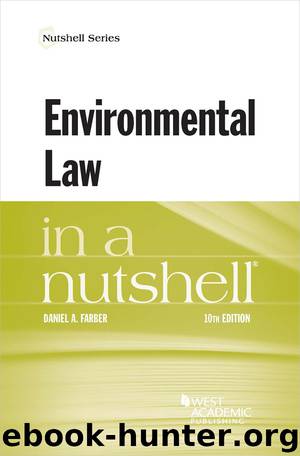Farber's Environmental Law in a Nutshell by Daniel A. Farber

Author:Daniel A. Farber
Language: eng
Format: epub
ISBN: 9781640201132
Publisher: West Academic
Published: 2019-07-25T16:00:00+00:00
b.BCT
As amended in 1977, § 304(b)(4)(B) spells out the criteria to be used in establishing BCT effluent limitations. Concerning cost considerations, the statute provides that BCT shall include “consideration of the reasonableness of the relationship between the costs of attaining a reduction in effluents and the effluent reduction benefits derived” and “comparison of the cost and level of reduction of such pollutants from the discharge from publicly owned treatment works to the cost and level of reduction of such pollutants from a class or category of industrial sources.” In 1979 EPA promulgated a BCT methodology that reduced this cost-reasonableness analysis to a single test: a comparison of the marginal costs of going (a) from BPT to BCT and (b) from “secondary treatment” to “advanced secondary treatment” at publicly owned treatment works (the POTW comparison test). EPA analyzed POTW costs and established a figure of $1.15 per pound as the appropriate marginal cost of advanced secondary treatment at a POTW. It then screened existing BAT rules for 41 industry subcategories to determine which rules passed the POTW comparison test.
Industry groups challenged the new BCT standards in American Paper Institute v. EPA, 660 158
F.2d 954 (4th Cir. 1981). They argued that § 304(b) called for a two-part cost-reasonableness test: a cost-effectiveness test and a POTW comparison test. EPA, on the other hand, argued that Congress did not require it to evaluate cost-effectiveness, but only mandated a POTW cost-comparison standard. EPA read the seemingly dual statutory requirements as one, commanding only a consideration of reasonableness. The court rejected EPA’s position and invalidated all the BCT regulations. EPA’s interpretation of the statute was found to be contrary to its plain meaning, ignoring the mandatory language (“shall”) and disregarding the conjunctive (“and”). On the other hand, the court concluded that EPA had not acted arbitrarily or capriciously in choosing advanced secondary treatment as the increment beyond secondary treatment for the POTW comparison test. In 1986, EPA adopted new BCT regulations, adding to the POTW test an industry cost-effectiveness test capping the incremental cost of BCT at 129% of BPT.
A later decision gives additional guidance concerning the role of cost in setting BPT and BCT. In Chemical Mfrs. Ass’n v. U.S. EPA, 870 F.2d 177 (5th Cir. 1989), the industry argued that BPT should be governed by a “knee-of-the-curve” test to determine the point at which the marginal cost of removal rises steeply. Increasing the removal of conventional pollutants for the chemicals industry from 96% to 99% would allegedly have cost almost twice as much per pound of pollutant as current treatment methods. CMA argued that this shift went well beyond the knee of the curve and was therefore 159
impermissible. EPA countered that the knee-of-the-curve test could be applied only to assess increases in limitations beyond BPT (that is, for BCT). The Fifth Circuit agreed with the agency:
The BCT provisions were intended to establish an intermediate level between BPT and the stricter BAT limitations for conventional pollutants by adding a cost-effectiveness test for incremental technology requirements that exceed BPT technology.
Download
This site does not store any files on its server. We only index and link to content provided by other sites. Please contact the content providers to delete copyright contents if any and email us, we'll remove relevant links or contents immediately.
Second Nature (The Shape-Shifter Series #1) by Jae(1056)
Petroleum Contracts by Peter Roberts(870)
The Global Commons by Susan J. Buck(868)
Infrastructure by Frischmann Brett M(813)
The Monk by Matthew Lewis(792)
Japan Travel Guide: Things I Wish I Knew Before Going To Japan (2019 EDITION) by Fukuyama Ken & Fukuyama Yuki(777)
Ever After by William Wharton(749)
Before Earth Day by Karl Boyd Brooks(716)
Good for You, Great for Me by Lawrence Susskind(709)
War of the Whales by Joshua Horwitz(687)
Biting the Hands that Feed Us by Baylen J. Linnekin(681)
Respecting Animals by David S. Favre(657)
Animal Law in a Nutshell by Frasch Pamela & Hessler Katherine & Waisman Sonia(656)
Uncommon Ground by William Cronon(655)
Rangeland Systems by David D. Briske(645)
After Nature: A Politics for the Anthropocene by Jedediah Purdy(642)
The Ethics of Space Exploration by James S.J. Schwartz & Tony Milligan(635)
Fracking the Neighborhood by Jessica Smartt Gullion(609)
Down to the Wire: Confronting Climate Collapse by David W. Orr(602)
